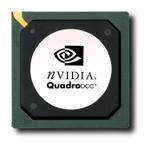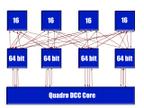|
|
 |
|
Workstation Smackdown (Nvidia Quadro DCC review) Added on: Mon Feb 04 2002 |
| Page: 1 2 3 4 5 6 7 8 9 10 11 12 13 14 15 |
The Heart of the Monster
 The GPU, friend of the 3D artist. Capable of feats beyond mortal man, these mysterious device removes a huge amount of overhead from the system processor, processing it on the card itself. Commonly referred to as a �Transforming and Lighting� engine, this part of the Nvidia processor is responsible for its raw polygonal throughput abilities. It determines how many polygons you can throw at the viewport before you get the infamous chug effect. The GPU, friend of the 3D artist. Capable of feats beyond mortal man, these mysterious device removes a huge amount of overhead from the system processor, processing it on the card itself. Commonly referred to as a �Transforming and Lighting� engine, this part of the Nvidia processor is responsible for its raw polygonal throughput abilities. It determines how many polygons you can throw at the viewport before you get the infamous chug effect.
(For those of you who don�t know the infamous chug effects, its similar to drinking a whole lot of beers at once.
First you get a little dizzy, your viewports start dropping frames, and then you usually fall.) The T&L (not the bar) engine free�s up the cpu for other tasks, like trying to get Max booleans to function properly. The Quadro�s GPU is theoretically capable of pushing a few million polygons a second, but these are all pure gross polygons (Not ugly, but unlit, unshaded, untransformed, unborn polys), and this number doesn�t really reflect actual performance. (Thus the whole point of this long winded, yet surprisingly humorous article).
All of this power fits into a tiny package which holds a scant few 57 million transistors. (20% more then a Pentium IV). What�s all these numbers and explanations mean to you, the end user? It means faster geometry manipulation in the viewport, smoother viewport animations, and greater poly management.
(Higher Polygon Ceiling) But all the power contained in this small .15 micron process would be useless without effective memory management. That�s where lightspeed comes in to effect. (Not a joke)
To Lightspeed and Beyond
One of the strong points of the Geforce 3 line (Quadro Included) its their incredible amounts of ram bandwidth. Using their patented �Lightspeed� technology, Nvidia is able to give their video cards poly crushing power, and the ability to quickly allocate critical ram resources to the crunching factory.
The Lightspeed memory technology works through the �Crossbar� controller, a set of four 64-bit controllers which help to reduce the latency of memory transactions.
( If you don�t know what latency is, try this simple experiment. Find a door in your house. Close it. Walk into the door. You might want to consider stopping before impact. Wait a second. Open the door. Now repeat this experiment, only this time, open the door as you get to it.
Reduced latency = less waiting. It is unknown at this time whether nvidia will patent this �less waiting� system at local Motor Vehicle Associations)
Here�s an example of how the controller works. On the left you�ll see a normal 256 bit controller and its corresponding four memory chips.
On the right (Quadro DCC) you�ll see the four 64-bit controllers. Red lines demonstrate communication between the entities.
 
As you can see in the images, the crossbar memory controller of the DCC allows for greater transmission of executed bandwidth, resulting is lower latency, higher bandwidth, and greater overall speed. Combined with the high speed DDR available to these controllers, the Nvidia line has an incredible amount of memory bandwidth to utilize, over seven gigabytes a second. This translates into higher resolution performance, in shaded and textured operations in the viewport, providing for less lag and more modeling power, under any circumstance.
But what is power without finesse. Letting loose a firehose on a pinhole accomplishes nothing. Unleash it on a crowd of Excite@Home users and you have a riot.
Nvidia tackles this use of power with an innovative and powerful feature known as shaders. (Not sunglasses). Pixel and Vertex to be exact.
|
 |
|
|




